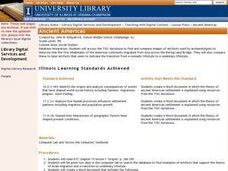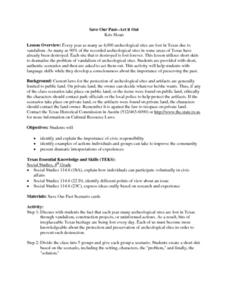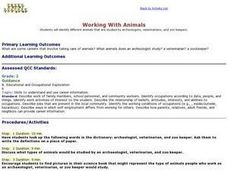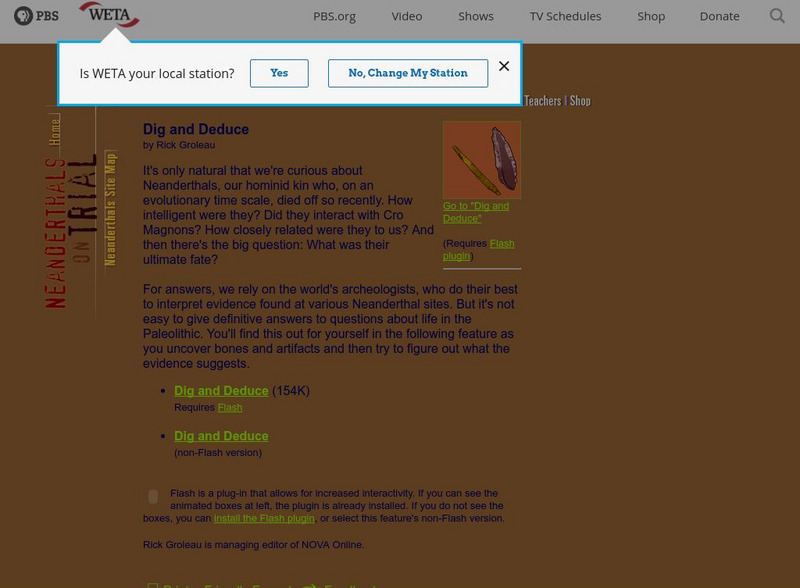Curated OER
Artifacts 2: Artifacts in Context
Students role play as archeologists to determine how artifacts tell about how people lived. In this artifacts activity, students look at pictures of artifacts of the ancient city of Catalhoyuk and tell what life was like there. They look...
Curated OER
Pottery Traditions
Students make and decorate a replica of a North Carolina coiled pot after summarizing why archaeologists study pottery and how Indian people of North Carolina made and used coiled pottery.
Curated OER
Ancient Americas
Seventh graders compare artifacts used by archaeologists to theorize the first inhabitants of the Americas migrated from Asia across the Bering Land Bridge.
Curated OER
Reading - Archeologist
For this online interactive archeologists worksheet, learners respond to 8 fill in the blank and multiple choice questions regarding the information included in the provided paragraphs.
Curated OER
Fossilworks
Students research fossils and fossil formation. They explain how fossils are formed, identify fossil formations and use casting plaster to produce fossil replicas.
Curated OER
Tools of the Archeologist
Young scholars review the job of an archeologist as a class. While viewing a PowerPoint presentation, they guess the use of the tool before the next slide is shown. They also discuss when the archeologist would use each of the twelve...
Curated OER
Gridding a 2 x 2 Meter Unit
Students use the internet to examine what happens at an archeological dig site. In groups, they practice measuring a 2x2 meter square unit and gridding it out as an archeologist would do. They review the possible solutions at the end of...
Curated OER
Archeological Thinking
Sixth graders review the differences between a historian and archaeolgists. At a recent archaeological dig site, they examine the artifacts and determine their usage. In groups, they are given a bag full of artifacts and write down what...
Curated OER
Save Our Past -- Act It Out
Fourth graders identify and examine the importance of civic responsibility and the result of losing many archeological sites in Texas. In groups, they are given scenerio cards and act out each scene for the class. They also write a...
Curated OER
Working With Animals
Second graders study careers that involve animal care such as veterinarians, zookeepers and archeologists. They create a collage of animal drawings related to the careers.
PBS
Pbs Teachers:neanderthals on Trial: Dig and Deduce
Examine methods archeologists use to interpret evidence and deduce what the evidence in uncovered bones and artifacts suggests about life in the Paleolithic era.
PBS
Pbs Teachers: Scientific American: Science Safari: The First People
Emulate the work of archaeologists in South Africa attempting to solve the riddles of human evolution by inferring a person's height from the length of one bone. Identify and communicate present-day rituals through ancient art techniques.
PBS
Pbs Teachers: Scientific American: Dead Men's Tales: Undisturbed Find
Emulate the work of archeologists by creating and excavating an archeological find. Record the exact location and position of every dig artifact to maintain the coherency of the find.
PBS
Pbs Teachers: Scientific American: Science Safari: City of Gold
Investigate the challenges facing archeologists when dealing with local cultures near dig sites, and consider the difficulty of remaining sensitive to the past yet still being able to learn from it.
PBS
Pbs Teachers: Scientific American: The Channel Island Fox
Explore the clues that archaeologists and other scientists use to piece together a picture of the past. Create models to compare and contrast the geology of two islands, and compare the characteristics of various types of fibers.
















